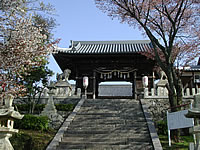
[ Large
view ]
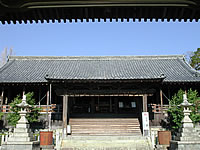
[ Large
view ]
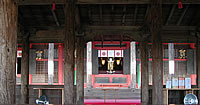
[ Large view ] - 
|
Susanowo-no-mikoto,
one of the very first gods in Japan, and his son, Isotakeru-no-mikoto
who is a god of planting, settled down on the top of Mt.
Hakuei over 2000 years ago during the Emperor Sujin Era.
A scholar, Makibi Kibi, received a message
from the gods and built a shrine at the place where the outer
sanctuary is now in 733 in the Emperor Shomu Era. Maiki
Kibi, worshiped as a god of scholarship, was the first scholar
who became the emperor's advisor and had been to China to
study during the Tang Dynasty. He mastered the yin-yang calendar
and wanted to propagate its teachings. Then he worshiped
Susanowo-no-mikoto, the main god in this shrine, as Gozu-tenno,
the god of the sky, and his wife, Kushiinadahime-no-mikoto,
as the god of the year. And he regarded 8 Susanowo’s
sons and daughters as the eight specialized gods. He worshiped
them as the gods of the Japanese calendar.
In 972 during the Heian Era, the main
hall was constructed at the present location and the
shrine where Makibi Kibi is worshiped was built in the
outer sanctuary. The present main hall was built in the
mid-Muromachi Era (about 600 years ago), and the worship
hall was repaired in the Edo Era (about 300 years ago).
Both halls are the biggest of their size in Japan, and
they are designated as Important National Cultural Properties. |
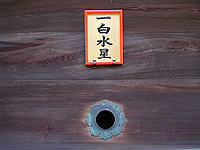
[ Large
view ]
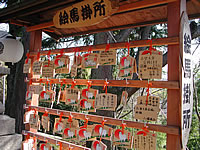
[ Large view ]
|
The
calendar always has something to do with our daily life,
such as choosing the date for rice planting, judging the
direction and the location of new construction, deciding
the time for happy and sad ceremonies, and getting advice.
Therefore, the gods in this shrine are widely worshiped as
the god of agriculture for a good harvest, the god of direction
for safe construction and the god of the nation's growth
for good business and family prosperity.
Mysterious 'Nine Holes' at the back of the
main hall represent nine stars in the yin-yang calendar.
Your star is determine by your birth year. Gods reside behind
each hole to protect the relevant star. You may whisper a
wish into the appropriate hole,
based on your birth year, after offering money and obtaining
a wish board. |
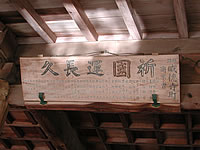
[ Large
view ]
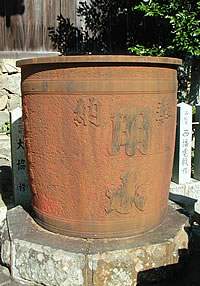
[ Large
view ]
|
Susanowo-no-mikoto
has been worshiped as the strongest god to purify evil, and
overcome disease and difficulties. In the mid-Heian Era,
a plague had spread widely in the Kyoto area for over 10
years. Emperor Seiwa had a dream to invite the god of Hiromine
to Kyoto. He did it and prayed to the god, and subsequently
the plague disappeared. People were delighted and held a
big festival, which was the beginning of the Gion Festival,
still held every summer in Kyoto.
At Hiromine Shrine the Setsubun-Risshun Ceremony
is held for two days from the day before the first day of
the spring in the yin-yang calendar and the first day of
the spring.
The carriage hanging in the worshiping hall
was used to carry a cloth to the Imperial Palace in Kyoto.
This cloth was used by The Emperor, the highest Shinto priest,
to purify his body. |

